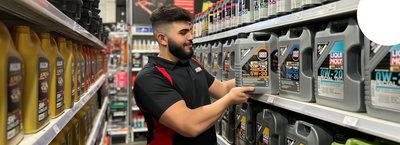Proper engine oil maintenance is essential for the smooth operation and longevity of your vehicle's engine. Engine oil lubricates vital components, reduces friction, and helps dissipate heat. Regularly checking and topping up your engine oil ensures optimal performance and protects your engine from unnecessary wear and tear. In this comprehensive blog post, brought to you by Universal Auto Spares, we will guide you through the step-by-step process of checking and topping up your engine oil, empowering you to take control of your vehicle's maintenance.
The Significance of Engine Oil
Before diving into the process, it's crucial to understand why engine oil is vital for your vehicle's performance. Engine oil lubricates moving parts, prevents metal-to-metal contact, and helps maintain proper engine temperature. Over time, oil can degrade, become contaminated, or experience loss due to consumption or leaks. Regularly monitoring and maintaining the correct oil level ensures optimal engine performance and protects against potential damage.
Tools and Materials Needed
Gather the following tools and materials before starting the process:
- Clean shop towels or rags
- Safety gloves and goggles
- Your vehicle's owner manual
- Engine oil (matching the manufacturer's specifications)
-
Funnel (if needed)
How to Check Your Engine Oil
Follow these step-by-step instructions to check your engine oil:
Step 1: Prepare Your Vehicle
Ensure that your vehicle is parked on a level surface and the engine has been turned off for at least 10 minutes. This allows the oil to settle back into the oil pan.
Step 2: Locate the Dipstick
Refer to your vehicle's owner manual to locate the engine oil dipstick. The dipstick is usually marked with a brightly colored handle and is inserted into the engine block.
Step 3: Remove and Inspect the Dipstick
Carefully remove the dipstick and wipe it clean with a shop towel or rag. Reinsert the dipstick fully, then remove it again to check the oil level.
Step 4: Check the Oil Level
Observe the markings on the dipstick, which indicate the minimum and maximum oil levels. The oil level should ideally fall between these two markers. If the level is below the minimum mark, it's time to top up your oil.
How to Top Up Your Engine Oil
If the oil level is low, follow these steps to top up your engine oil:
Step 1: Select the Correct Oil
Consult your vehicle's owner manual to determine the recommended engine oil type and viscosity. Ensure that the oil you choose matches these specifications.
Step 2: Locate the Oil Filler Cap
Locate the oil filler cap, which is usually labeled and located on the top of the engine. Remove the cap to access the oil reservoir.
Step 3: Add the Engine Oil
Using a funnel if necessary, pour the engine oil slowly into the oil reservoir. Be careful not to overfill, as this can lead to other issues. Add the oil in small increments, periodically rechecking the oil level with the dipstick.
Step 4: Recheck the Oil Level
After topping up the engine oil, reinstall the dipstick and remove it again to verify that the oil level is within the recommended range. Avoid overfilling the oil reservoir.
Signs Your Oil Needs Attention
-
Oil Warning Light: If the oil warning light comes on, stop driving and check your oil immediately.
-
Dark or Dirty Oil: Fresh oil is amber in color; dark, gritty oil needs to be changed.
-
Engine Noise: Tapping or knocking sounds may mean oil is low and parts aren’t being lubricated.
-
Reduced Fuel Efficiency: Engine oil that’s too old or low can cause your engine to work harder.
Dangers of Overfilling Your Engine Oil
While low oil levels can damage your engine, too much oil is also dangerous. Overfilling can lead to:
-
Foaming and aeration of the oil, reducing lubrication
-
Increased pressure in the crankcase
-
Leaks or seal damage
-
Catalytic converter issues due to excess oil burning
Always add oil gradually and recheck levels after each pour.
Oil Disposal Tips
-
Never pour used oil down the drain, in the bin, or onto the ground.
-
Collect old oil in a sealed container.
-
Take used oil to your local auto parts store or a certified recycling center.
-
Many workshops and councils offer free oil disposal services.
Frequently Asked Questions (FAQs)
How often should I check my oil?
Ideally, check your oil every 2-4 weeks or before any long trip.
Can I use a different brand of oil than what’s in my engine?
Yes, but always use the same viscosity and API rating. Mixing brands isn’t harmful if the specs match.
How long can I drive with low oil?
Driving with low oil can cause severe damage very quickly. Top up immediately or avoid driving until resolved.
What’s the difference between synthetic and conventional oil?
Synthetic oil offers better protection, cleaner operation, and longer service intervals but may cost more.
Final Thoughts
Maintaining your engine oil level is one of the simplest yet most important tasks you can perform to ensure the health and longevity of your engine. By following the steps above, you can avoid costly repairs, improve fuel efficiency, and enjoy smoother vehicle performance.
Universal Auto Spares offers a wide selection of high-quality engine oils and maintenance tools.



